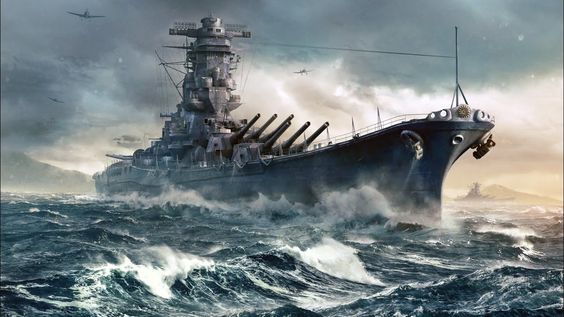When we think of Japan’s military history, one ship that often comes to mind is the Yamato battleship. However, buried beneath the depths of the sea lies a tragic story of its final chapter. Have you ever wondered about the forgotten tale of the Yamato shipwreck?
The Yamato battleship, commissioned during World War II, was the pride of the Imperial Japanese Navy. It was known for its immense size and powerful weaponry. Despite its reputation, the Yamato met a tragic fate and was lost during the war. Over time, the story of this formidable battleship has been overshadowed by other historical events.
The tragic tale of the Yamato shipwreck serves as a reminder of the devastating impact of war and the human cost it entails. This article delves into the forgotten history of the Yamato battleship, exploring the events leading up to its sinking and shedding light on the untold stories of the brave men who served onboard.
What was the biggest battleship of all time?
The biggest battleship of all time, the mighty Yamato, holds a prominent place in naval history. Constructed by the Imperial Japanese Navy during World War II, this colossal vessel embodied strength and power. With its awe-inspiring size and unparalleled firepower, the Yamato stood as a symbol of Japanese naval supremacy. However, despite its formidable reputation, tragedy struck when it was sunk by American forces in 1945.
The legacy of the Yamato lives on through its tragic demise and the subsequent discovery of its shipwreck in 1982. The remnants of this once-mighty battleship serve as a poignant reminder of the enormous sacrifices made during wartime. Furthermore, exploring the shipwreck sheds light on both the technological marvels and devastating consequences inherent to naval warfare. The story of the Yamato continues to captivate historians and enthusiasts alike, offering profound insights into our complex human history and relentless pursuit of power at sea.
What aircraft carrier sunk Yamato?
The sinking of the Yamato, Japan’s legendary battleship, has been a subject of speculation and controversy for decades. Despite popular belief, it was not an aircraft carrier that delivered the final blow to this formidable warship. In fact, it was a combined force of American carrier-based aircraft and surface ships that ultimately brought down the Yamato on April 7, 1945.
Contrary to the misconception perpetuated in some sources, no single aircraft carrier can claim credit for sinking the Yamato. During Operation Ten-Go, a desperate attempt by Japan to attack Allied forces off Okinawa, the Yamato fell victim to relentless aerial assaults from multiple U.S. carriers such as USS Hornet and USS Intrepid. Through coordinated attacks involving dive bombers and torpedo planes, these carriers collectively contributed to delivering fatal blows upon the Yamato.
It is important to dispel the notion that a sole aircraft carrier was responsible for sinking this iconic battleship. The reality is that it took a coordinated effort from multiple carriers working in unison with other naval assets to deal the fatal blows that led to the demise of the Yamato. This serves as a testament to the power of collaborative military strategy in achieving decisive victories during wartime.
What ship killed the Yamato?
The sinking of the mighty Japanese battleship Yamato is a legendary tale of naval warfare. However, it was not just one ship that led to its demise, but rather a coordinated attack by multiple American vessels. On April 7, 1945, during World War II, the Yamato was ambushed by U.S. forces in Operation Ten-Go.
Although no single ship can claim sole responsibility for the sinking of the Yamato, it was a combined effort that sealed its fate. The overwhelming force brought to bear by American carrier-based aircraft proved too much for even the mighty Yamato to withstand.
Where is the Yamato ship now?
The whereabouts of the Yamato ship, Japan’s legendary battleship from World War II, has long been a subject of fascination. After being sunk by American forces in 1945 near the island of Okinawa, the wreck lay undiscovered for decades. However, in 1985, the Yamato was finally located at a depth of nearly 1,400 feet off the coast of Japan. The discovery sparked renewed interest in this historical relic and raised questions about its preservation and significance.
Today, the Yamato shipwreck remains at rest on the ocean floor as a poignant reminder of wartime conflict and human ingenuity. Though efforts have been made to study and commemorate the vessel through exhibitions and documentaries, there is ongoing debate about how best to honor its legacy while respecting its status as a war grave.
Who would win Bismarck or Yamato?
The Bismarck and Yamato are two of the most powerful battleships in history, each with its own strengths and weaknesses. The Bismarck, launched in 1939 by the Germans, was known for its speed, firepower, and advanced technology. On the other hand, the Yamato, commissioned by Japan in 1941, boasted impressive armor and immense size. However, while both ships were formidable in their own right, a hypothetical battle between them would likely depend on various strategic factors such as positioning, crew training, and tactical prowess.
One interesting point to consider is that despite their differences in design and capabilities, both ships ultimately met similar fates. The Bismarck was sunk during World War II after being pursued by British forces in May 1941; meanwhile, the Yamato was also destroyed by American forces during a suicide mission near Okinawa in April 1945. This parallel outcome highlights the harsh realities of naval warfare during this period and raises intriguing questions about which ship would have prevailed had they engaged each other directly.
Another fascinating aspect to explore is how the remnants of these legendary vessels continue to capture public imagination. The recent discovery of the wreck of the Yamato off the coast of Japan reignited interest in its story, shedding new light on its historical significance and sparking renewed debate about its potential performance against rival battleships like the Bismarck. It’s clear that even decades after their demise, these mighty warships continue to evoke awe and fascination among enthusiasts and historians alike.
What was the weakness of the Yamato ship?
The Yamato, the symbol of Japanese naval power during World War II, was certainly a formidable vessel. However, despite its massive size and impressive armament, the ship had several weaknesses that ultimately contributed to its downfall. One significant flaw was its vulnerability to air attacks due to limited maneuverability and lack of proper air defense systems. This weakness became evident during the Battle of Okinawa when American aircraft carriers targeted and sank the Yamato with relative ease.
Another critical weakness of the Yamato was its heavy fuel consumption and limited range, which severely hindered its operational capabilities. The ship’s immense size meant it required substantial amounts of fuel to operate efficiently, leaving it susceptible to being stranded far from home ports or supply lines. This logistical challenge made it difficult for the Yamato to effectively carry out prolonged military campaigns without constant refueling support.
Ultimately, despite its imposing presence and firepower, these vulnerabilities proved fatal for the once-mighty Yamato as it fell victim to a strategic bombing raid near Okinawa in 1945, serving as a poignant reminder that even the most formidable naval vessels are not invincible.
Was the Yamato bigger than the Bismarck?
The debate over whether the Yamato was bigger than the Bismarck is often a topic of controversy among naval history enthusiasts. While both were formidable battleships, the Yamato holds the title as the heaviest and most heavily armed battleship ever built. Weighing in at an impressive 72,800 tons and armed with nine 18.1-inch guns, the sheer size and firepower of the Yamato eclipsed that of its German counterpart.
However, size alone does not necessarily equate to superiority in combat. The Bismarck, though slightly lighter at 50,900 tons and armed with eight 15-inch guns, was known for its technological advancements and agility in battle. Despite their contrasting strengths and weaknesses, both battleships played significant roles during World War II.
Today, remnants of the Yamato can be found scattered on the ocean floor near Okinawa following its sinking by American forces in 1945 – a haunting testament to its once overwhelming presence on the seas. In contrast, the Bismarck met a similar fate when it was sunk by British forces in May 1941 off the coast of France. The shipwrecks stand as poignant reminders of a bygone era marked by fierce naval supremacy.
What caused the Yamato to sink?
The sinking of the Japanese battleship Yamato is a tragic tale rooted in the final days of World War II. While it was ultimately destroyed by American forces, there were several factors leading to its demise. The sheer size and power of the Yamato made it a prime target for Allied forces, as they sought to eliminate one of Japan’s most formidable warships. Additionally, Japan’s dwindling resources meant that the Yamato was sent on a desperate mission with little air support or protection.
Furthermore, poor tactical decisions and faulty intelligence also played a role in the sinking of the ship. The lack of adequate air cover left the Yamato vulnerable to relentless attacks from American aircraft carriers, ultimately leading to its destruction. In essence, a combination of strategic missteps and resource scarcity contributed to the tragic sinking of this monumental vessel, marking the end of an era for Japanese naval power.
Who survived the sinking of Yamato?
The sinking of the Yamato battleship during World War II was a catastrophic event, yet amidst the chaos and tragedy, there were survivors who defied the odds. One remarkable survivor was Mitsuru Yoshida, who miraculously managed to escape from the sinking ship and endure days adrift at sea. His harrowing tale of survival, resilience, and determination serves as a testament to the human spirit in times of extreme adversity. Another survivor, Mochitsura Hashimoto, who served as a junior officer on the Yamato, also escaped the doomed vessel and went on to contribute his experiences to historical accounts of the tragic event.
The stories of these brave individuals offer invaluable insights into an event that is often overshadowed by its sheer magnitude. Their firsthand accounts shed light on the human cost of war and provide a unique perspective on one of history’s most significant naval tragedies. As we commemorate their endurance and fortitude in facing such overwhelming circumstances, it is essential to recognize their contribution in preserving a crucial chapter in world history. These survivors’ accounts stand as poignant reminders of hope amidst despair and illustrate humanity’s unwavering capacity for bravery in times of unimaginable peril.
How many died on Yamato?
The sinking of the Japanese battleship Yamato during World War II remains a tragic and haunting event in maritime history. The vessel, once the largest battleship in the world, met its demise on April 7, 1945, as it came under relentless attack by Allied forces. The death toll from this catastrophic event is estimated to be around 2,475 lives lost, making it one of the deadliest naval disasters of the war.
Despite being a staggering loss of life, the sinking of the Yamato also stands as a stark reminder of the human cost of conflict and warfare. It serves as a poignant example of the sacrifices made by those caught up in geopolitical struggles beyond their control. As we reflect on this somber chapter in history, it’s imperative to pay homage to those who perished aboard the Yamato and acknowledge their bravery and sacrifice amid such devastating circumstances.
The wreckage of Yamato continues to serve as a solemn memorial and underwater grave for those who lost their lives that fateful day. As we honor their memory, we are compelled not only to remember their sacrifice but also to strive for peace and understanding in an ever-changing world.
Has Yamato wreck been found?
After decades of speculation and search efforts, the wreck of the legendary Japanese battleship Yamato has finally been discovered off the coast of Japan. The sheer size and armament of the Yamato made it a formidable adversary during World War II, and its sinking in 1945 has captivated historians and enthusiasts alike. The discovery of this historic wreckage has reopened discussions about the significance of the Yamato’s final resting place, shedding new light on a pivotal moment in naval warfare history.
The exploration of the Yamato shipwreck offers an unparalleled opportunity to uncover more details about its fateful sinking and learn from this important piece of maritime history. Additionally, discovering the wreck allows for a deeper understanding of not only military tactics but also technological advancements that have shaped modern naval warfare. This finding also holds promise for further research into preservation efforts and marine conservation to ensure that this iconic piece of history is respectfully remembered for generations to come. As explorations continue, we can anticipate even more revelations emerging from this long-lost relic at the bottom of the sea.
Conclusions
In conclusion, the Yamato shipwreck stands as a poignant reminder of Japan’s tumultuous wartime history and the devastating impact of World War II. The tragic fate of this once-mighty battleship serves as a symbol of the human cost of war and the harsh realities faced by those who serve in armed conflicts. As we reflect on the story of the Yamato, it is important to honor the memories of all those who lost their lives and to strive for peace and understanding among nations. Let us not forget the lessons that can be learned from this somber chapter in history, and work towards a future where such tragedies can be avoided.




